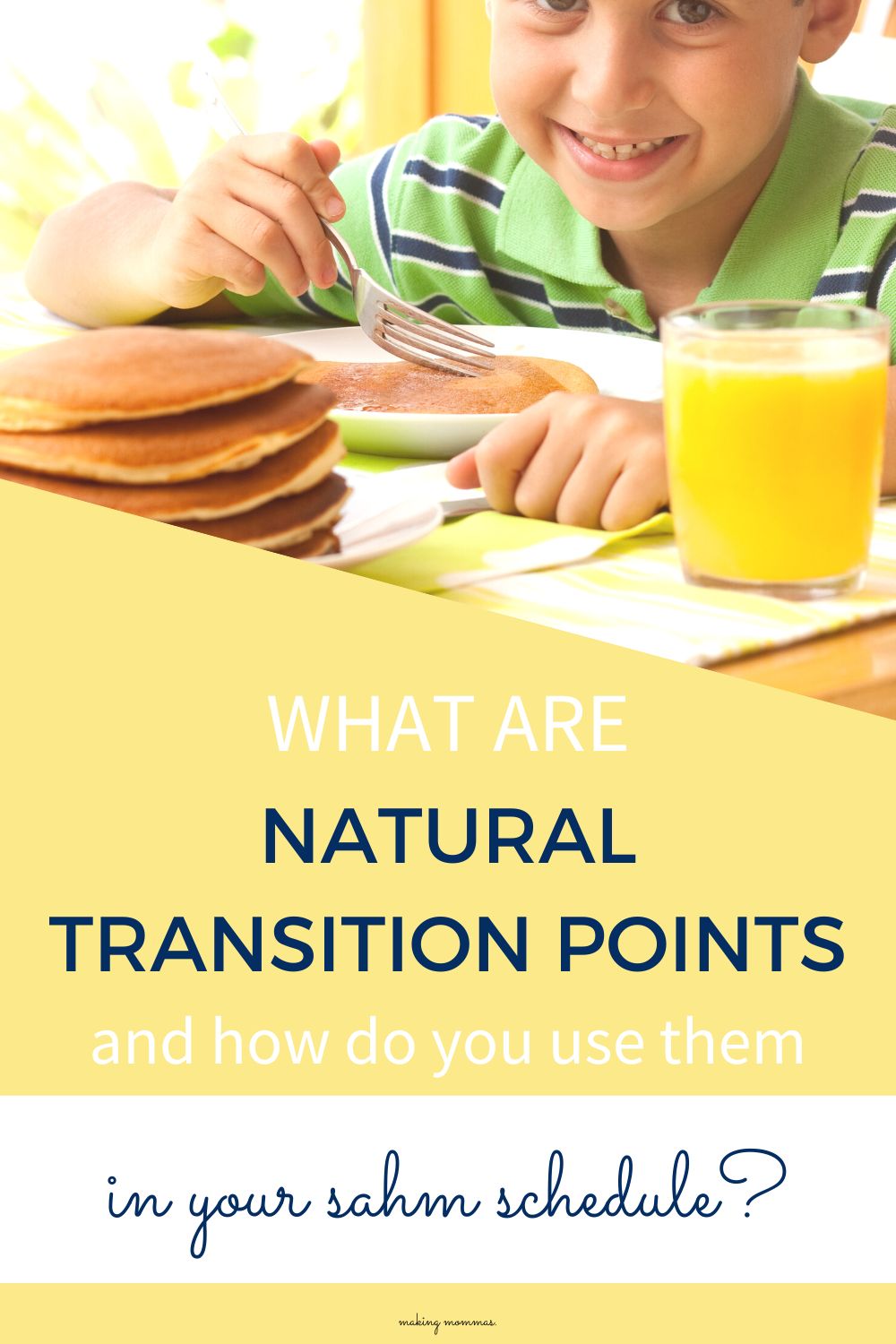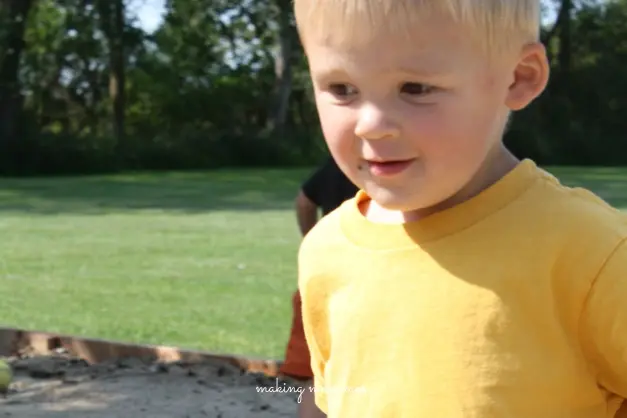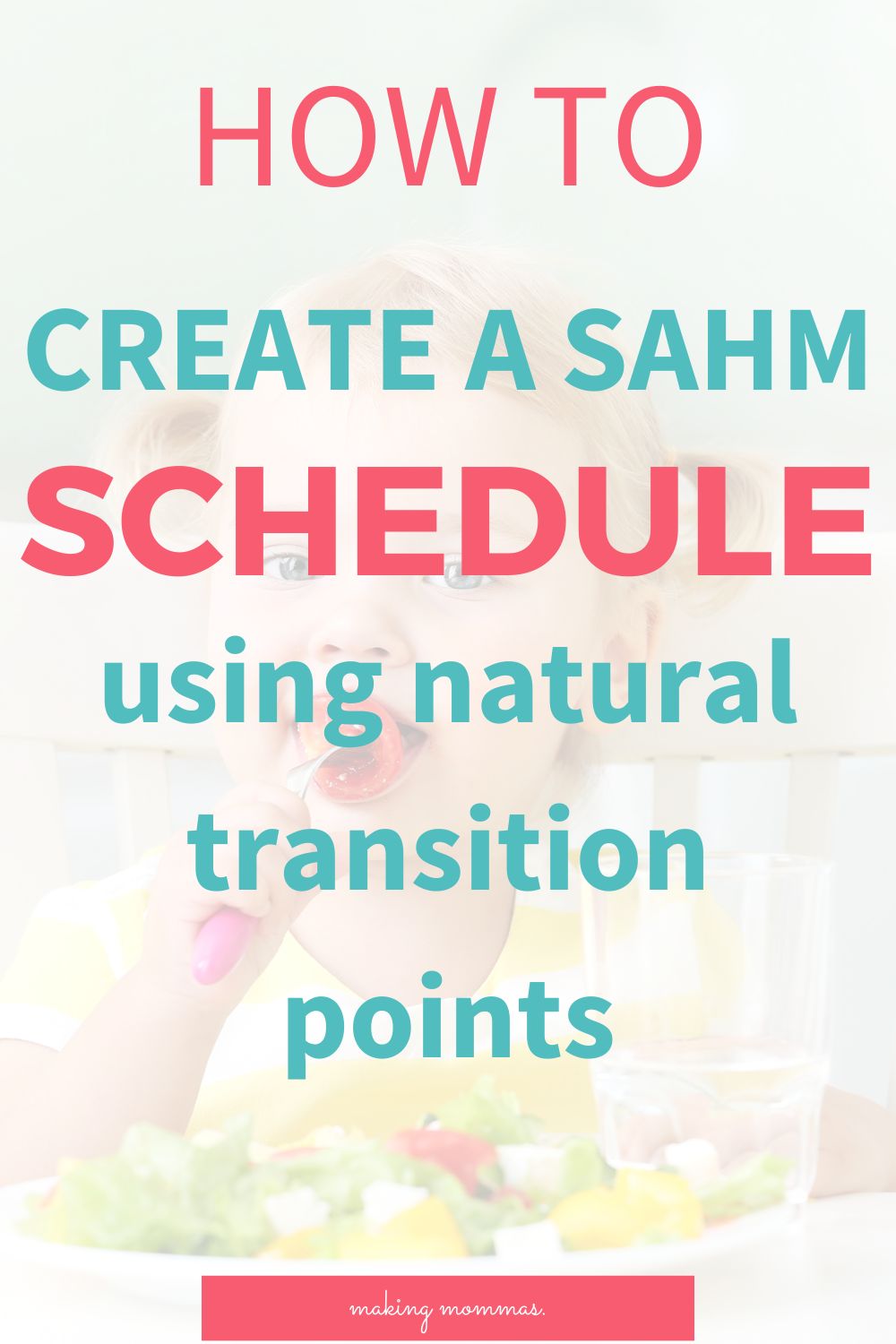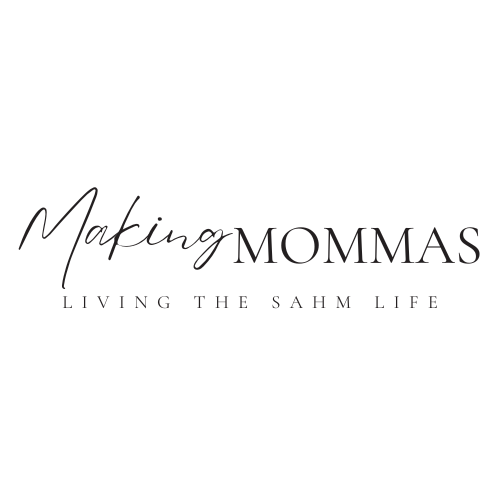Ready to conquer your days as a stay-at-home mom? Learn how to create a SAHM schedule using natural transition points and make the most of your time at home.

Do you know what natural transition points in your daily routine are?
They are those fluid intervals that just naturally happen and make it easy to switch gears. Like breakfast time, lunch time, nap time, or even when your favorite TV show ends!
Well, recognizing and making the most of these moments can seriously level up your Stay-At-Home-Mom schedule!
Trust me, adding natural transition points to your routine is a real game changer when it comes to organization and balance in your life! Let me tell you, as someone who used to use them in a preschool classroom, they really work like magic! 😄
In this post, we’re gonna dig into how to spot these magical transition points and seamlessly incorporate them into your daily routine.
Let’s get that SAHM game strong! 💪😄
What are Natural Transition Points?

Natural transition points are moments in our daily routines that lend themselves to a change in activity. They are segments of time that naturally occur throughout the day, and where shifting from one task to another feels organic and not forced.
These could be moments such as after finishing a meal, when a child goes down for a nap, or even after a favorite TV show ends.
Identifying your own natural transition points requires a careful evaluation of your daily routine.
Start by jotting down the activities you do from the time you wake up to the time you go to bed, and note the time it usually takes to complete each activity.
Then, observe when it feels natural to switch from one task to another. These moments are your potential natural transition points.
Remember, these points may vary from one individual to another, as they are deeply personalized and revolve around your daily activities and lifestyle habits.
Why is it Important to Use Transition Points in Your Daily Sahm Routine?

Utilizing natural transition points in your daily SAHM routine is crucial for several reasons.
First and foremost, they lend structure to your day, creating a predictable routine that not only helps you manage time effectively but also minimizes stress associated with unpredictability. For moms, having a structured day means being able to balance chores, leisure, and child-care without feeling overwhelmed.
For children, routines instilled through transition points provide a sense of security and control over their environment. Kids thrive on predictability, and a structured routine helps nurture their emotional well-being.
It aids in establishing healthy habits such as regular meal and sleep times, which are pivotal to a child’s growth and development. Moreover, these transitions can help children learn the concept of time, patience, and the importance of completing activities in a timely manner.
In a nutshell, incorporating natural transition points into your daily routine paves the way for a smoother, more harmonious day-to-day life for both you and your child. Bolstered by predictability and structure, you’ll find your days more enjoyable and less stressful.
Plus, your child will benefit from the stability and regularity that these routines provide.
How Do You Use Natural Transition Points in Your Daily Sahm Routine?

Incorporating natural transition points into your daily SAHM routine is a practical and effective strategy. These transition points can largely depend on your child’s needs and your household tasks.
For instance, waking up in the morning can be considered the first transition point of the day. This is when you can involve your child in a morning routine like brushing their teeth and getting dressed. The completion of these activities can serve as a cue for breakfast, a critical part of their diet.
Next, the period immediately after breakfast could transition into a learning or playtime session. This time can be utilized for interactive activities that stimulate your child’s cognitive and social skills.
After playtime, the transition to lunchtime can occur, followed by a nap.
The afternoon may transition from quiet time to a more active period, with outdoor play or structured indoor activities. Dinner time serves as a transition point towards winding down the day, followed by a bedtime routine that includes activities like reading a story, brushing teeth, and finally going to sleep.
Remember, these transition points are flexible and can be adjusted to suit your child’s and your family’s unique needs. The key is to maintain consistency once you establish these routines, as it helps your child understand the flow of the day and what to anticipate next.
The Natural Transition Points I Used in My Stay at Home Mom Routine

When my kiddos were little, I had all these funny little tricks to make our day run smoothly!
One of my favorites was snuggling on the rocking chair. It was like a signal to start the day and get our morning routine rolling.
Then, it was breakfast time – a chance for the munchkins to fuel up and get their energy levels soaring! Breakfast is a great natural transition point. It’s easy to chunk down your day when you use meals to break it up.
Naptime is another great natural transition point. I used a mini routine before and after naptime to transition into the rest of the day.
Before naptime, we read stories and ran through our bedtime ritual. After naptime was a little snack, that was perfect for easing us into our afternoon routine.
And supper always transitioned us into our evening routine, which was bathtime and a little family time. We’d follow that up with our calming bedtime routine, and before we knew it, the little ones were off to dreamland!
Ah, those were the days! Our routine looks so much different now. 🥹
How Can a Stay-at-Home Mom Make the Most of Natural Transition Points in Her Routine?

You can maximize natural transition points by setting consistent times for specific activities, such as meals, playtime, and nap time.
By creating a visual schedule for children to follow, you can help them develop a sense of routine and structure.
Additionally, incorporating fun and engaging activities during these transitions, like storytelling or art projects, can make the experience more enjoyable for both you and your children.
It is also important to use this dedicated time as an opportunity to connect with your children, engage in meaningful conversations, and build positive relationships that will last a lifetime.
How Can Natural Transition Points Change as Children Grow Older?

As children grow and develop, their needs and routines will also change. Natural transition points may shift from naps to quiet time, or from bath time to independent showering.
It is important for you to adapt their routine accordingly, while still maintaining structure and consistency.
This can also be a time to involve your children in decision-making and allow them some independence in their routine.
Communication is key, as well as being flexible and open to change. As your children become more independent, natural transition points may decrease, but they can still remain important for maintaining a sense of structure and rhythm in the day.
Ultimately, it is important for you to be adaptable and find what works best for your unique family dynamic.
By utilizing natural transition points, you can create a more balanced and fulfilling routine for you and your kiddos.
At the End of the Day….

At the end of the day, it’s all about creating a nurturing home that helps your kiddos grow and thrive.
Finding those natural transition points in their daily routines can bring some structure and rhythm to their lives, benefiting both you and your mini-me. This flexible strategy, combined with open communication and a willingness to go with the flow, can help your little ones feel more secure, gain independence, and make the most of each day.
Remember, starting and ending the day with a comforting routine can create an awesome childhood experience that will stick with them forever!
Before You Go!
Before you leave, don’t forget to check out our insightful post, How to Create a Daily SAHM Routine Using Time Chunking.
This guide will provide practical and effective strategies for chunking down your day, utilizing natural transition points to develop a structured daily routine for your family.
It’s time to embrace a routine that promotes growth, independence, and an amazing childhood experience for your little ones.
Don’t wait any longer—click the link and start enhancing your daily SAHM routine today!
More on Schedules & Routines
12 Super Important Benefits to a Daily SAHM Routine
The Secret to a Great Stay At Home Mom Schedule
How To Structure Your Days As A SAHM
How to Create The Best Morning Routine for Your Stay at Home Mom Schedule
Wanna Create the Best Ever Stay at Home Mom Schedule? Here’s How!


